Trystan asked a very good question on my last post about court dress: “A lot of the fashion plates make the skirts look more round than the flat rectangular shape seen in the extant gowns. Is this just artistic license or were there different styles needed different under-structure shapes? Bec. some of them look almost like there’s a round hoop worn under the gown, not side panniers, or maybe some weird cross-breed between the two. Or maybe it’s the same panniers with really fluffy petticoats that round out the look. Or again, artistic license!”
This is a great question, because (besides a shift and stockings), the first thing one needs under a French robe de cour, and many other 18th century court gowns, is a panier or hoop (also called “hoop-petticoat” in English; incidentally, panier translates as “basket”).
So what did French court paniers look like? Were they different from regular paniers, or paniers worn in other countries? Did sizes and shapes change over time? I can’t answer all these questions, but I can tell you what I’ve found out so far!
The 18th century hoop was probably invented in England, where there are references as early as 1709 (Chrisman). They begin appearing in France in about 1718-19. Initially, it was a rounded dome shape; from 1725-30, it was more shaped like an oval bell with a circumference of about eleven feet. It was in the 1730s that the fronts and backs flattened to create the shape we think of when we think of the 18th century panier (Boucher). According to François Boucher, “There were all sorts of paniers: funnel-shaped paniers à guéridon, dome-shaped paniers à coupole, paniers à bourrelets flaring out at the foot of the gown, paniers à gondoles which made women resemble ‘water-carriers,” and elbow paniers, on which the wearer could rest her elbows, and which the 1729 Mercure describes as being more comfortable than paniers à guéridon.” Amalia Descalzo writes that the elliptical hoop of the 1730s was called “paniers à coude” or “à commodité (74). Most historians agree that full paniers (as opposed to the shorter, knee- or thigh-length hoops, or pocket hoops) went out of fashion in the second half of the eighteenth century except for court wear. In 1765, Diderot’s Encyclopédie wrote that the style of the panier “lasted a long time, and is not yet passed” but was falling from fashion; “One goes today in town & to the theater without panier, & one does not wear them anymore on stage…”; however, the 1785 Encyclopédie Methodique complained in the 1785 that the panier “reigns at the theater, where it is seen in all its ridiculousness on the dancers” (the court gown was frequently worn by actresses and dancers, a fact which surprised me!).
Thus, the main occasion in which French women wore paniers in the second half of the century was for the robe de cour, under which it was required. Kimberly Chrisman-Campbell writes that the size of the court panier fluctuated with fashion, the rank of the person wearing it, and the solemnity of the occasion. She argues that in the 1740s, it grew very large following general trends, but stayed enormous when more modest paniers came into fashion. She cites the grand duchess Maria Feodorovna of Russia, who was presented at Versailles in a panier of six aunes (24 feet or 8 yards); and the Cabinet des Modes (1786), which noted that while large paniers were not frequently worn for fashionable wear, they were worn at court.
The 1785 Encyclopédie Methodique gives the most information about court paniers:
“The English paniers are those that are worn under court ensembles & under theater costumes; they have a height of ¼ ½ or 7/8 [aunes?] and their width is three or four aunes. They are lined with baleen, and more commonly in cane as it is less heavy. This cane is a small reed from India that is cut on both sides to make it more square; it is covered with strips of fabric that are sewn to the skirt with which they form the panier. This skirt is made in taffeta, but ordinarily in toile legere [canvas?]. The English paniers have three coudes [elbows, see below].
“The name coude [elbow] is given to a portion of cane or baleen that is only placed on the side of the skirt, and precisely in the elbow, & which is attached by its two ends, one in front, the other in back, on the first row of canes that entirely circles the panier [in other words, the arching canes on each top corner].”
“There are some paniers à l’Anglaise or paniers de Cour, of a lesser size than those indicated previously; these ones do not have but a row of cane underneath three elbows, the others [the bigger paniers? something else?] have two.
“The name coude is given to a small panier which has no more than two elbows on a sole row of cane that supported and ended the panier; it was the height of fashion, and it is passed now like a thousand other things.”
So what did French court paniers look like? Unfortunately, none still exist, and I have yet to find any images of specifically French court paniers! Luckily, there are two 18th century Swedish court ensembles, with paniers, that still exist:
The pattern for Lovisa Ulrika’s panier and entire ensemble (yay!) can be found in Norah Waugh’s Cut of Women’s Clothes… weirdly placed in one of the glossy photo inserts, underneath the photo of the dress. My memory is that there’s a pattern of Sofia Magdalena’s panier out there somewhere, but I can’t remember where — am I crazy? Remind me if you know either way!
Thanks to Andrew, who found these two c. 1760 paniers:
There is also this English panier that seem helpful. English paniers were known for being more boxy than French, but this doesn’t seem to follow that rule:
Because there are no extant French court paniers, I wanted to find another way to get some information on sizes and shapes. I was inspired by American Duchess’s post on panier proportion to do something similar, except with paintings (I’m not convinced that museums always know exactly what shape and size hoop should go under a given skirt; I’m sure the Livrustkammaren has made reproductions of the extant Swedish court paniers to support the corresponding gowns, but other museums have to made educated guesses when working with dresses that do not have a surviving panier). I decided to focus on images that I thought were trying to be relatively realistic, and so avoided fashion plates as those always seem exaggerated to me.
In order to examine silhouettes, here are a bunch of images of French court dress with my bad Photoshop annotations. First, I outlined in red what I thought was the general side silhouette of the panier. Then, I wanted to compare sizes, so I marked the width of the waist in green, and then copied that shape to see how the measurements of the panier compared. Being a tall girl and so interested in height vs. width, I also marked in blue the height of the wearer, and compared that with the hem width of the panier. The big problem, of course, is that nearly ALL of the images I’ve seen of women in court paniers show them standing at an angle (if you know of any full face images, send them my way!). So that means we’re dealing with perspective, and so nothing is going to be spot on. And, of course, we can assume the painter is A) flattering the sitter (probably tinier waists than reality!) and B) tweaking reality to suit their own, or the subject’s, taste.
The overarching lesson that I get from this is that yes, there is definitely variation, but also that it seems that all the French court hoops have an curved/arched top corner (using the “elbow” canes) and some degree of flare on the side (from a little to a lot). There is also some degree of downward slope (from a little to a lot) starting at the waist (only “Presentation of the portrait of Maria Antonia of Austria” has a completely horizontal side). None of them have the squared off corners and vertical lines seen under English court dresses. Despite references in the Encyclopedie (above) to knee-length hoops, I’m not seeing any of the silhouettes that you’d see wearing that kind of hoop (of course, it could be that shorter hoops were worn for less formal occasions; having your portrait painted in court wear is obviously the most formal).
Hoops of the 1720s-30s were definitely narrower overall than those that came later.
Looking at the later images, it looks like the narrowest are those seen in “La Dame du Palais de la Reine” (1789), “La Dame de Cour” (1776), and the Carmontelle images (“Mademoiselle d’Azincourt,” “Mademoiselle Lani,” and “Portrait de Mademoiselle Sophie d’Arnoult”); these vary from just under the width of the waist to just under twice the width of the waist (before they start to go into the elbow curve). The hem width of the panier appears to be equal to about 1/2 to 3/4 of the wearer’s height.
The 1730s-40s portraits of Marie Leczinska are all 1 to 1.75 of the waist width (before beginning the elbow curve), and a lot of flare from the elbow to the hem — although none have as much flare as the extant 1751 Lovisa Ulrika paniers. The hem width appears to be about 3/4 of the wearer’s height.
The 1770s-80s images of Marie-Antoinette are all almost 2x the waist width (before beginning the elbow curve). The 1775 & 1778 images show a lot to a medium amount of vertical flare. The 1783 image has far less vertical flare, but there’s still a little bit there. Hem width is 3/4 to just under the wearer’s height.
And then there are the slightly weird outliers, like “Naissance de Louis-Xavier-François,” which shows a pre-teen/teenage girl (probably Marie-Therese, Marie-Antoinette’s eldest daughter) wearing quite small hoops… and “The Royal Family Around Louis Joseph,” in which nobody seems to be wearing any hoops at all!! Make of THAT what you will!
Sources
Francois Boucher, 20,000 Years of Fashion
Kimberly Chrisman-Campbell, “Le Grand Habit et la Mode en France au XVIIIeme Siecle,” Fastes de Cour et Ceremonies Royale
Amalia Descalzo, “La Permanence du Panier dans les Cours Europeennes,” Fastes de Cour et Ceremonies Royale
Encyclopédie Ou Dictionnaire Raisonné Des Sciences, Des Arts Et Des Métiers, vol. 11, 1765
Encyclopédie Methodique, 1785
Norah Waugh, Cut of Women’s Clothes
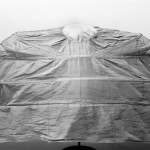
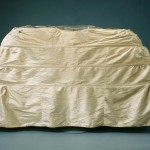
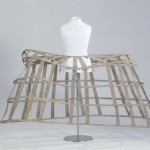
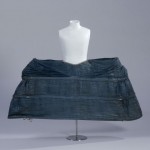
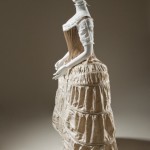
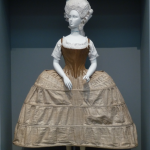
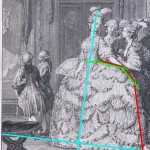

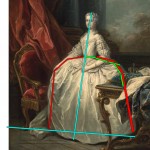
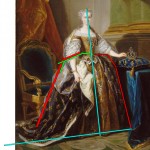
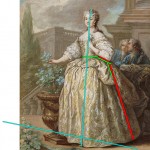
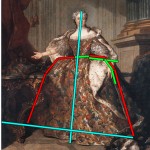

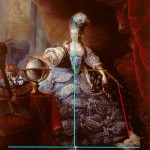
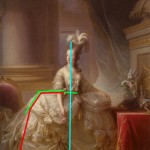
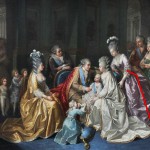
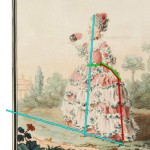

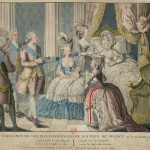
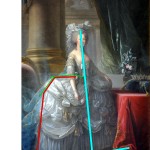
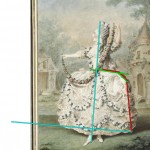
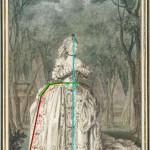
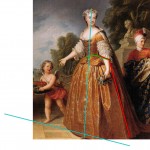
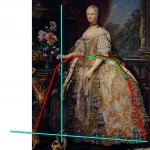
Didn’t Janet Arnold make a pattern of one of the Swedish dresses?
Andrew, that’s what I was thinking too — she did, but it’s Sofia Magdalena’s 1766 wedding dress, which is super useful except doesn’t include a panier pattern.
This is super helpful and interesting, Kendra. Thanks for sharing all your research and thoughts! I’m just confused at one point: can you clarify the ratio/numbers when you say “Width vs. height on these seems to be about 1/2-3/4 of the wearer’s height.”
Best,
Quinn
Also! Two pairs of panniers from the German Historical Museum:
http://objektkatalog.gnm.de/objekt/T901
http://objektkatalog.gnm.de/objekt/T3070
COOL!
Good question, Quinn – I was losing steam by that point! What I was trying to say is that the hem width of the panier appears to be equal to about 1/2 to 3/4 of the wearer’s height.
This is such a great post! I’m so inspired to go make a huge panier, I might have to revise my dress plans 🙂
Caroline
Hello this is all really useful and wonderful! I have a slightly irrelevant question, though. Where do I go to claim my dress for the event?
Nevermind I found it.
Very interesting and thorough!
Sofia Magdalena’s panier pattern is in History of Costume by Blanche Payne, first ed. page 567 or possibly 367 (I’ve only seen a photo of it, at http://glittersweet.deviantart.com/art/Rococo-Panier-1-128127710).
I’ve noticed that Boucher includes a photo of Louisa Ulrica’s gown (pic 720), as one of three examples of the “ungraceful, exaggeratedly artificial style” outside France… as opposed to the graceful, exaggeratedly artificial style of France, I suppose. 😉 He mentions the extreme width in particular. Now, your quote from the Encyclopédie Methodique says paniers are three or four aunes wide. 1 aune is 118 cm, so 3 to 4 aunes is 354 to 472 cm (11’7″ to 15’6″ – I’m pretty sure they mean circumference rather than actual width!). According to Waugh’s diagram Louisa Ulrica’s panier is “just” 420 cm around the lowest hoop, which would make it only slightly above average size.
By the way, the Encyclopédie Methodique sounds like a great resource; is it by any chance online?
Interesting! So I guess the end result is that the round fashion plates are just exaggerated artistic license then (as opposed to the more realistic portraiture). The ones I’m thinking of are these:
1760 – http://opac.lesartsdecoratifs.fr/fiche/robe-de-cour-face-et-dos-0
1785 – http://opac.lesartsdecoratifs.fr/fiche/figure-de-mode-dame-en-habit-de-cour-1785-4
1786 – http://opac.lesartsdecoratifs.fr/fiche/figure-de-mode-dame-en-robe-de-cour-retroussee-sur-le-cote-droit
1788 – http://opac.lesartsdecoratifs.fr/fiche/figure-de-mode-dame-en-robe-de-cour-de-presentation-avec-panier-garnie-en-echelle-de-jacob
1789 – http://opac.lesartsdecoratifs.fr/fiche/figure-de-mode-dame-en-grande-parure-de-cour-la-francaise
Also this one extant Russian gown looks awfully round – http://fripperiesandfobs.tumblr.com/post/2704050464/court-dress-of-empress-elizabeth-petrovna-state
Tho I supposed that could be the museum displaying it incorrectly.
I just want to get the shape right (before I go off & make the rest of it crazy & goth!).
Anna Carin — I’m off to look at Blanche Payne today, will report back what I find! Yes, the Encyclopedie Methodique is online, thanks to fabulous Google Books: http://books.google.com/books?q=editions:UOM39015064548467&id=FnRMAAAAMAAJ
Trystan: I do think it’s a bit of artistic license — I have a post coming up in the next few days that will address this, with visuals! And I checked on Elizabeth Petrovna (the extant gown you linked), it looks like she was an adult from the 1730s-1762 (crowned in 1741). So yes, it could be the museum getting the shape wrong, or maybe it’s an early shape, or maybe they did things differently in Russia at that time!
The Marie Antoinette dresses from 1778 and 1783 are the same dress – the train is different (the ’78 is a matching ivory, the ’83 is blue with gold fleur de lys) as are the accessories, but the dress itself seems identical. They are even painted by the same artist (Vigee-Lebrun). Wonder why the panier shape is different? Things that make you go “Hhmmm”.
Victoria – you’re right, and that IS weird!!
Grand Ladies is my go-to site for costume porn and where I found the image of the dress I’m doing, which has a front-facing subject:
http://www.gogmsite.net/grand-ladies-of-the-1700s.html
http://www.gogmsite.net/grand-ladies-of-the-eightee/subalbum-queen-maria-caroli-2/maria-carolina-by-francesco.html
Wow, what a fantastic post, and so thorough! (not that I expect any less from you). I’ve also rather wondered about some of those rounder court robe shapes. Frankly, I thought they looked a little funny, though I suppose the super-square/boxy English ones are certainly no less funny-looking. I’ve been wanting to try making one of the hoop petticoats with ‘elbows’ – can I assume you’ll be making one? If so, would you consider doing a sort of dress diary about it? I’m so curious about the mechanics of it.
I just know I’m going to wish I could participate in this court robe venture, but that silly little thing called my PhD dissertation always gets in the way of my fun! lol ;o)
Which one of this were used with the robe a l’anglaise?
Are there any period images or extant examples of the dome-shaped hooped petticoats? I’m going to need one in February and right now the plan is to mess with a 19th century cage crinoline pattern.
I too have wondered how museums determine the shape of the understructure of dresses that require one, be it panier, cage crinoline, bustle, or whatever.
What nobody seems to have mentioned is that many of the “boxy” panier dresses have a seam that lies horizontally along the top of the panier. The side fullness is usually pleated fan-wise at the end of this seam. The Red dress with the fur trim (Queen Maria Carolina) clearly shows this seam, and it is evident in photographs of many of the extant dresses in various museum collections.
David — yes, good point! Altho I’d want to double check the pattern — makes sense that that would be there for the boxy panniers, but you could theoretically curve that line…